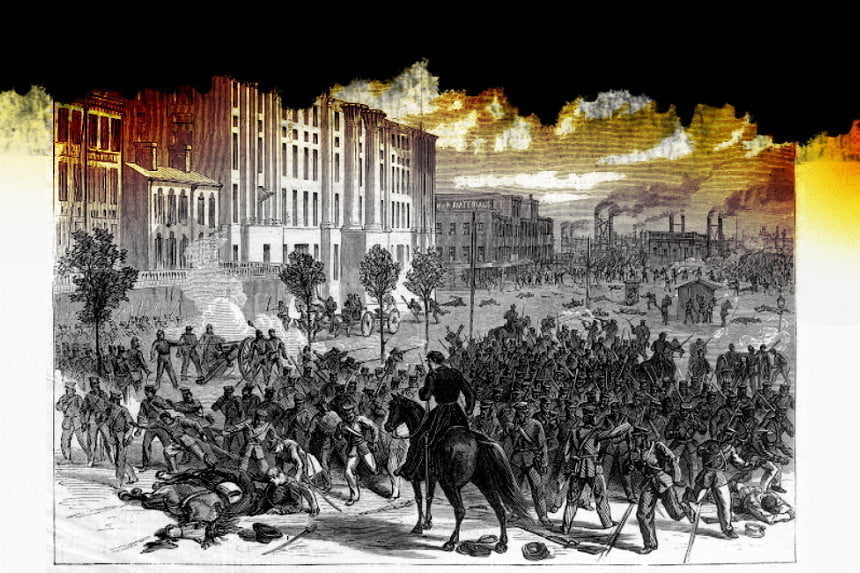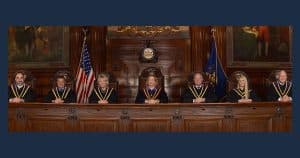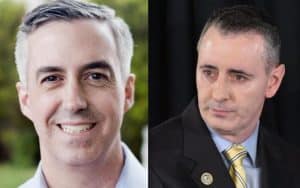The history of white conservatism in the U.S. is a history of coups, massacres, and vigilantism. While that may be a shocking idea to many, it is simply a matter of historical fact. White conservatives used violence, intimidation, and deprivation to overturn Reconstruction and to limit the effects emancipation. They blacklisted and fired Black Americans for voting. They beat, kidnapped, and tortured Black folks for demanding their wages and for requesting equal protection from police and the courts. From Camilla to Colfax, white conservative politicians worked hand-in-hand with racist paramilitary groups to murder Black elected officials who dared to hold office. White politicians like Ben Tillman even won election because of their support for and participation in coup and massacre events like the 1876 Hamburg Massacre.
This racist violence isn’t incidental to white conservatism — it is its defining feature.
One coup attempt in particular, the White League Coup of 1874, illustrates both how and why white conservatives used direct violence to seize power and shows the danger of the current Republican Party. Among its lessons is a daunting one for those of us facing down a resurgent fascist movement in today’s GOP: allowing coup organizers to go unpunished destabilizes existing institutions and all but guarantees their eventual capture or destruction by racist insurrectionists like Tillman.
As with the January 6th Insurrection, the White League Coup began when white conservative candidates refused to concede defeat after their voter suppression measures failed during the Louisiana state election of 1872. The losing gubernatorial candidate, former insurrectionist and renowned racist John McEnery, rejected the outcome of the election and formed a shadow government complete with fraudulent legislators, tax collectors, and sheriffs. These false officials, not unlike the slates of false electors organized in 2020 by the Republican Party, harassed legitimate officials, and tried to prevent them from fulfilling their duties. The resulting intimidation campaign forced legitimate officials like T.M.J. Clark—the Black president of the State Insane Asylum—out of office and made it nearly impossible for those remaining in their posts to run the government.
Clark’s story is not all that different from public officials and election workers targeted by Republicans today, run out of their roles by the threats, harassment, and conspiracy theories that form the heart of white conservatism. And as with Trump and many of his appointees, those who forced Clark from office amid a torrent of harassment and conspiracy theories did so at least in part to cover up and further enable the embezzlement schemes of white conservatives.
McEnery’s shadow government and its White League paramilitary arm would eventually resort to several direct armed revolts against the legitimate government, culminating in its successful 1874 coup. However, as with the “Stop the Steal” campaign orchestrated by the Republican Party to overturn the 2020 presidential election, the McEnery camp made convoluted legal arguments in addition to its vigilante efforts to undermine multiracial democracy. F.C. Zacharie, for example, outlined the legal steps that the Grant administration could take to bring McEnery’s shadow government to power. He concluded his legal brief with a threat, spelling out that white conservatives would resort once more to direct violence if they were not given sole control of the state government: “Its solution is now easy by peaceable means, hereafter it may require rivers of blood to reestablish the principles once submerged.” As with Trump lawyer Rudy Giuliani, who organized election lawsuits based on fabricated claims and helped engineer the fake elector scheme before encouraging the January 6th insurrectionists to engage in “trial by combat,” the white conservatives in McEnery’s inner circle viewed direct violence as the logical result of their fraudulent petitions and conspiracy theories.
Just as Republicans worked hand-in-hand with white paramilitary groups like the Proud Boys, who Donald Trump famously told to “stand by” during a live presidential debate, white conservative politicians partnered closely with the paramilitary White League. Partnering with the White League, which became the enforcement arm of the McEnery shadow government, accelerated and systematized white conservative attacks on multiracial governance in Louisiana. In conjunction with white politicians, the White League kidnapped and killed Black teachers and voters, assassinated Black officials, and burned Black homes, churches, and schools. They even orchestrated large-scale massacres of Black officials, their extended families, and their white political allies in Colfax and Coushatta. Their message was clear: if they could not win exclusive control of the state by intimidation, fraud, and violence, white conservatives would burn it to the ground and murder any who stood in their way.
Crucially and consistently, those in power refused to hold these white paramilitaries and their political organizers accountable. While they organized hearings on White League “depredations,” legitimate state and federal authorities failed to prosecute those organizing the attacks on Black Louisianans and their white political allies, allowing them to operate with impunity. If that sounds disturbingly familiar, it should.
In order to increase support for insurrectionary violence, members of the White League circulated outlandish rumors of a “Black League” operating with the support of the legitimate governor, William Pitt Kellogg. “Nobody ever thought of a White League,” the official paper of the White League claimed, “until the Black League with its secret signs and declared purposes were well known and the threat of the negroes had been made that Louisiana belonged to them.” The only problem? No such organization existed. As with “antifa,” the bogeyman that Trump’s DHS tried to manufacture to justify anti-protest violence and crackdowns, the “Black League” existed only as a pretext for white supremacist violence.
The White League used their own imagined Black League conspiracy theory as an excuse for publicly drilling in paramilitary units as they prepared to overthrow the state government. When they got word that their arms shipment was going to be impounded, they used it as an excuse to put the coup into motion. The day before their insurrection, much like the Stop the Steal rally of our own time, the White League press put out a call to the “Citizens of New Orleans” to assemble to defend “that right so solemnly guaranteed … in Article two of the amendments” and to counter the “usurping government.” With their supporters armed and ready for action, the organized White League paramilitary units sprang into action on September 14, 1874, erecting several barricades in the center of the city from which to launch their attack. In the wake of the fighting, which pitted ex-Confederate soldiers against the city’s multiracial police force, the White League ousted Governor Kellogg and toppled the legitimate state government.
Although the U.S. military accepted the surrender of the White League insurrectionists and returned the legitimate government to power, their continued unwillingness to hold white conservative insurrectionists accountable all but signed the death warrant of multiracial democracy as well as those of hundreds of its supporters. While the Kellogg government remained in power in and around New Orleans, years of white conservative intimidation, suppression, and massacres made it nearly impossible for the state to safeguard the rights of its citizens.
Black Louisianians in particular understood that they could be beaten, fired, kidnapped, and killed for voting. Under such circumstances, democracy itself could not survive. It ended in another torrent of white conservative violence during the election of 1876, the same election during which Ben Tillman orchestrated the Hamburg massacre that would catapult his political career and culminate in his election as the governor of South Carolina in 1890.
By now, the tactical and ideological similarity between the White League coup and the January 6th Insurrection orchestrated by the Republican Party should be clear—and with these similarities, the dangers of the ongoing GOP voter suppression and white paramilitary organizing should also be obvious. Time and again, white Americans refused to hold white conservatives accountable for using blacklisting, disenfranchisement, harassment, intimidation, violence, and massacres to capture state institutions and eliminate their political opponents. The fruits of our collective unwillingness to subject white conservatives to the rule of law are, in part, what brought us the 1/6 insurrection in the first place. The question now is what we can do differently to guarantee a stable, equitable, and just future for all. It is not one we should answer lightly.





